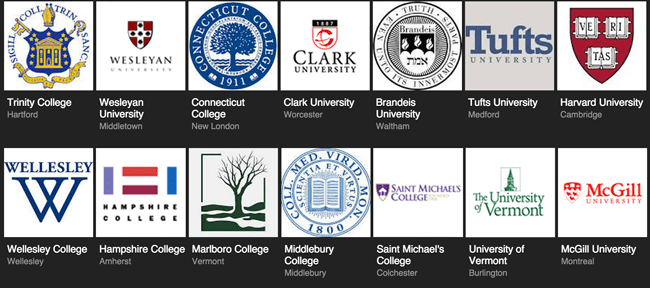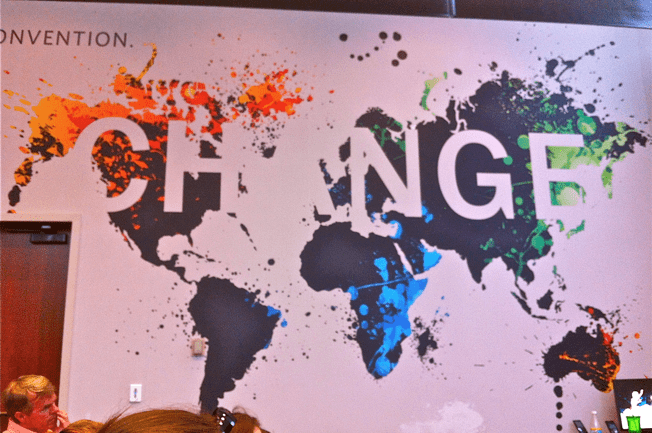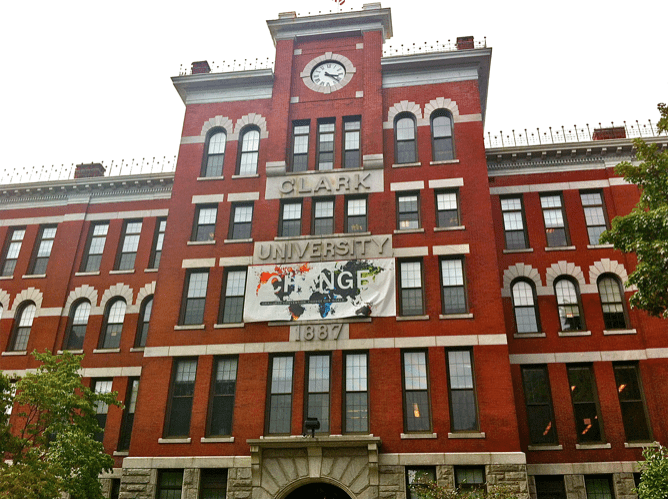I just completed a New England colleges tour with my two high school daughters. I took the trip, in part, as an opportunity to look at these colleges’ retail brands. My daughters and I were, in effect, retail shoppers in the market for a college or two, and each college got roughly 2.5 hours to make its pitch.
Interestingly, most of them fared rather poorly as brands.

All of them the same
After we’d been through about ten colleges my kids put it into words: “They all say the same things.”
The colleges we visited almost all seemed to be fighting a quixotic battle with a particular foe. The outline of this foe can be discerned from the things that were most strongly and commonly asserted in the scripted messages we received. The spokespeople of New England’s self-described elite liberal arts colleges warned us of a leviathan that looks like this: he has large classes taught by professors who either leave teaching up to assistants or who don’t care about students enough to remember their names. His classes are lecture style. His exams serve as the principal grading mechanism, and he encourages competition instead of collaboration among students for those grades. All his opportunities for research are taken up by graduate students who get the vast majority of his love and attention.
By contrast, these colleges present themselves as exemplars of a shining alternate path. What they say is indeed laudable, but interestingly, most of them fail to distinguish themselves from each other. Perhaps there are no meaningful differences among them, and so this leaves them having to hold themselves up in contrast to a caricature of a stereotypical “large university.”
Are they really competing with large universities or with each other?
This tactic certainly raises the question of who actually is the competition in the minds of the students these schools wish to attract. Are they really competing with large universities or are they competing primarily with each other? If it’s the former and they are seeking to convince students not to choose large universities, they were rather effective with my kids. After 15 small(ish) school pitches their reaction to McGill, which on the surface has many of the characteristics of “the leviathan,” was definitely negative. I can only speculate if this reaction would have been the same without the previous exposure to such a persistent stream of big university bad mouthing.
If, on the other hand, the truth is that most of the students that these smaller colleges wish to attract are actually those who already know they want to attend a smaller liberal arts college, then there is a serious problem with the substance and uniformity of the message we were given. While each school attempted to impress upon us—their retail shoppers—that they have something special, the things that truly make them special were not easy to extract from any of their pitches. We had to piece it together like some kind of brand puzzle or “spot the differences” game.
The things that truly make them special were not easy to extract from any of their pitches.
Because we were viewing so many colleges at once, I had my kids fill in a response sheet immediately after each visit so they could keep them all clear in their minds. On this sheet they noted likes and dislikes, general impressions, a rating, and finally whether or not they intend to apply.
The Brand Idea
My younger daughter, who came along for the last 14 colleges we visited, took to writing a single word in her “general impression” column. It’s essentially a Brand Idea extracted from her 2.5 hour interaction with each institution. She did this with no encouragement or advice from me.
Here is what she wrote in the order that we took the tours:
Trinity College: Chill
Wesleyan University: Snooty
Connecticut College: Basic
Clark University: Cool
Brandeis University: Bland
Tufts University: Interesting
Harvard College: Challenging
Wellesley College: Nature
Hampshire College: Free
Marlboro College: Family
Middlebury College: Selective (after concluding that “common” was not self explanatory enough)
St. Michael’s College: High school
University of Vermont: Opportunity
McGill: Strict
Princeton University: Vanilla
St. John’s College: Literature
Interestingly, her favorite institution was the one she could not easily find a Brand Idea for: Middlebury. The best she could come up with for two days after that visit was “common,” by which she meant it was the best of all the schools that offered essentially the same thing. It held all the positive features of New England’s liberal arts colleges, it just did all that stuff better than the others. After thinking about it for two days, however, she settled on “selective.” I think this was to make it easier to explain why it was her first choice.
I would like to highlight the handful of schools that deviated sufficiently from the norm to stand out as brands.
At the end of the day, it was the college with the best amenities that finally won their hearts.
Only one of the student-led tours felt like it provided something other than a practiced propaganda pitch, or in some cases, a kind of confessional of the student’s undying love and devotion to the school. It was at Marlboro College in Vermont where we may have caught them unprepared (or maybe the truth just shone through because this school is so different). This tour was the only one that willingly exposed some of the darker aspects of college life (things like excessive drinking, isolation, students failing to prosper, etc.). All of this was conspicuously missing in every other case. I was totally convinced by this honesty, and it made me wish my children could see what I was seeing. For them, however, it did not matter, and I think this was because Marlboro had a weak amenities presentation. Marlboro seems to have been unable or unwilling to join the “arms race,” the mad scramble that has taken place over the last 20 years to remake colleges as “student resorts” with massively expensive infrastructure and amenities enhancements. We toured through what at times amounted to an amenities parade, and at the end of the two weeks, it was the college with the best amenities that finally won their hearts. We’ll get to that in a moment.
The info session at Tufts was, tragically, the only one that took the Socratic method seriously. All other college presenters were so determined to deliver their informational goods that they could not spare a moment to ask any meaningful questions. But Tufts did, and this approach clearly set them apart in my kids’ minds (despite a very standard tour). In fact, this worked both for me and for the kids, and earned the school extremely high marks all around. So for what it’s worth, Tufts won the info session competition simply by asking real questions of the participants.

Other than Clark, the only college that really worked for them as a brand was Harvard. Harvard was, in fact, the only school that existed as a brand for my kids prior to setting out on this trip, and while they did a version of what all the other colleges do, all Harvard really had to do to garner excitement was to whittle away at the stereotypes already held in the heads of every student there. They essentially said, “We are not that ‘big university’ that everyone is warning you against.” After this they simply let their celebrity status ooze out from the venerable seams of the campus, house system, and friendly student tour guides. 35,000 paying supplicants each year for 2,000 slots. Not bad.
All the other colleges failed to effectively communicate a strong and coherent brand through their pitches. The “Free” that came to my daughter for Hampshire College, for example, was the doing of our tour guide who used “free” as a mantra to describe how many things on campus are free because they are included with tuition. The fact that his message was able to utterly supplant any institutional brand message from this very distinct college is a sign that the brand projected from the school itself was inadequate. Because Hampshire College has not done the work of simplifying and systematically applying its brand message, this slight verbal injection by a tour guide was able to run roughshod over it.
If Hampshire is naturally distinct, Marlboro College is distinctiveness on steroids; and yet this truth was only slowly squeezed out of our college tour experience, and even then, the unique appeal of Marlboro may have remained hidden from my kids. For Marlboro, where the truth of the brand is so significantly different from all the rest, why not simply open a window onto it (which they sort of did through the honesty of our tour guides)? Why not skip the tour entirely and simply preview the experience of learning as practiced there? Aping the facilities touring formula of the other schools put Marlboro in the same evaluative lens, and for my kids this (sadly) threw them out of the running.
College brands
So back to Middlebury. Why did it win this round?
It seems that it was able to ride the liberal arts wave with the most polish. Its brand is the same brand as almost all the other schools we toured; it just had all the accoutrements in the best combination for my kids. Put another way, it won the arms race. This is probably what makes this whole process work despite a preponderance of poorly expressed brands.
Many of the admissions people we encountered described the process of choosing a college in terms of fit. It’s as if each student is expected to sample enough colleges to absorb the general brand—that of the liberal arts college—and then it’s just a matter of finding the one with the most suitable set of amenities. The one with the “personality” that fits. The Why of the brand then becomes, “because I feel most comfortable here.” In this pattern, amenities matter, because they—along with the personality of the students each institution is able to attract—are the visible manifestation of fit. This is also the subject of much of the tours themselves, both because they are literally showing the built highlights of the campus, and also because the tour guide is telling you the story of who they are and why they fit there. By this logic, if you like the amenities and you like the tour guide, these are good indications that you are going to fit at that school.
As an institution pitching to the outside world (not to its students or alumni) it’s much easier to communicate your What—buildings, amenities, majors offered, sports teams, and your How—student to teacher ratio, student personality, small classes—than your brand, your distinctively delivered value to the world and to me. That’s probably why so many of these great institutions have not really bothered to formulate a brand.
In the absence of differentiating ideas, the focus has to fall to the features and attributes of each institution.
This is also a contributing factor in the facilities/amenities arms race that has been driving up the cost of an undergraduate degree. If you think it through, in the absence of differentiating ideas, the focus has to fall to the features and attributes of each institution. It’s all they are able to really talk about because they don’t really have a brand that is strong enough to permeate the thick membrane that separates their inner brand reality from the outside world.
The college brand challenge
And now, to speak directly to the colleges and universities vying for the attention of “customers” like me and my kids: I realize that you are all immensely rich and complex institutions that have to be many things to many audiences and constituencies, but unfortunately for you, competition is fierce and only becoming more so. Brands matter, and the bulk of you seem to think of brands as colors, type treatments and amenities, not as ideas that must live in the minds of your brand consumers.
If any of you on my daughter’s list don’t really like the one word description she gave you, then perhaps you need to think more deeply about your brand because, like it or not, that is what it IS. Your brand is what she thinks it is. Not what you think it is. Your college brand is right there in one word, despite your two thousand word protestation otherwise. All the blue and gold and green and yellow in the world does not make any difference if what my daughter retains about you is “bland.”
This was not my reaction to Brandeis at all, by the way. My word would have been something like “shiny,” but this inconsistency of the message received is exactly my point. What Brandeis intended to communicate got lost in the blur of What and How, and we were left with whatever scraps of a Brand Idea we could each glean from the wreckage.
Your brand is what she thinks it is. Not what you think it is. Your college brand is right there in one word, despite your two thousand word protestation otherwise.
This post is the product of frustration. Frustration from watching my girls casually dismiss colleges for reasons that had far more to do with What than with Why, and in so doing, cut off their own path to finding out more about the many great and subtle opportunities these institutions may offer. I felt that my daughters focused on the wrong things in part because they were being shown and told the wrong things. So I have to wonder if these great colleges and universities are abdicating a responsibility to be clear about why they exist and why they matter.
Dear liberal arts colleges:
Are you happy with the ongoing amenities arms race? Can you find ways to express who you are with enough clarity and meaning that you can be remembered as more than the sum of your course offerings and facilities? Can your delivered value be more clear not only to those on the inside—yourself, your students and your alumni—but also to those on the outside—prospective students and parents like us?



Very interesting. I’d guess that there’s some resistance in education to the idea of brand and marketing. They have negative connotations for some people, usually because they have a poor understanding of those concepts (almost everyone does).
This article may take a few reads from people who don’t already have a good understanding of what brand means, and what it doesn’t mean (eg, pretending to be something you’re not; selling people something they don’t need). Many people would do well to read the last paragraphs first, to understand what brand means, then the article.
Thanks for fascinating perspective, valuable because I do not think of the colleges as selling themselves really. Their websites are awful, and the candy-colored amenities which decorate everything but the education remind me that tuition has been diverted from paying professors to luring in the unwary, who do not realize that college dollars have long been channeled away from anything remotely educational into frills. Thus, I am unsurprised that the “pitching” of McGill did not resonate. It doesn’t have to, it is a great place in a great city. I went there, so biased. They are Canadian so have not entirely been swept away by American consumerism yet, so do not bother to sell amenities, and it’s a state school that is still focused on core subjects like education. Middlebury is also a great place, and one likely to deliver the goods.
GREAT article. I’m a brand strategist, and I went to Hampshire. It saddened me to learn that a single campus tour could negate all other existing branding efforts by this school (which is truly unique) and most of the other schools. Makes me wonder if such a critical part of the admissions process – and brand story delivery – should be left in the hands of a single undergrad tour guide.